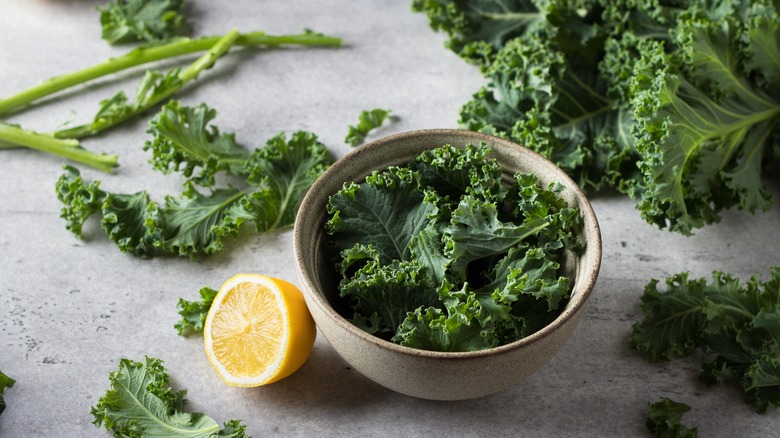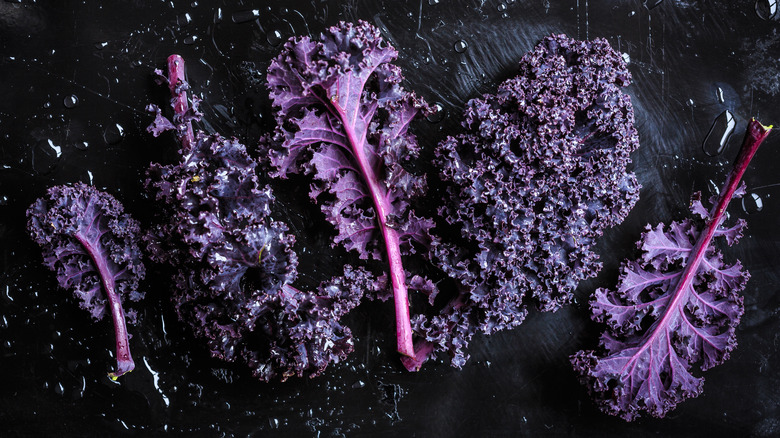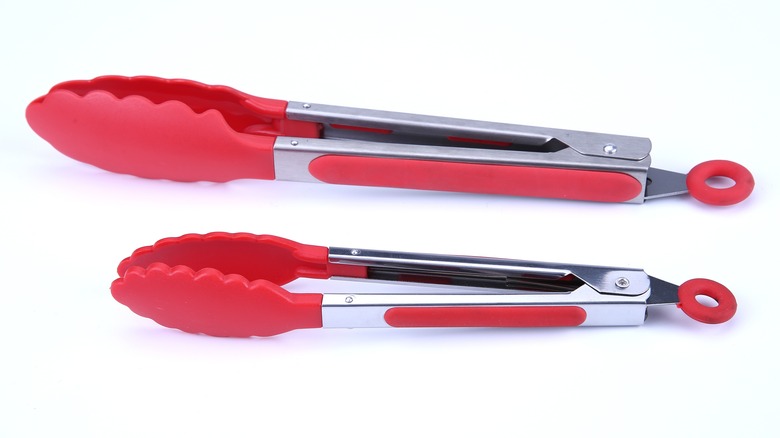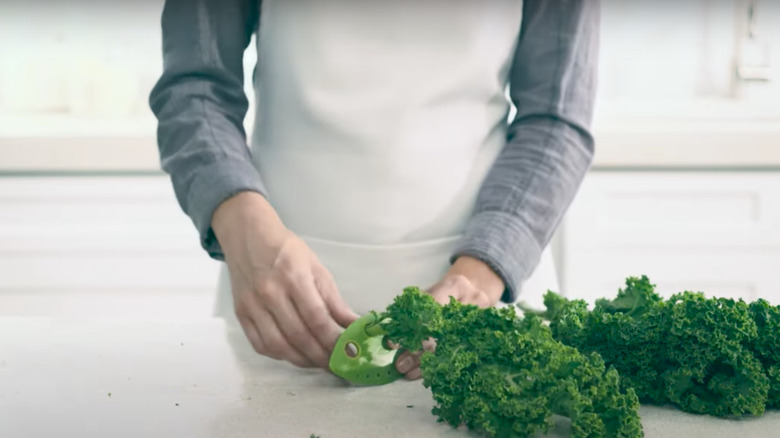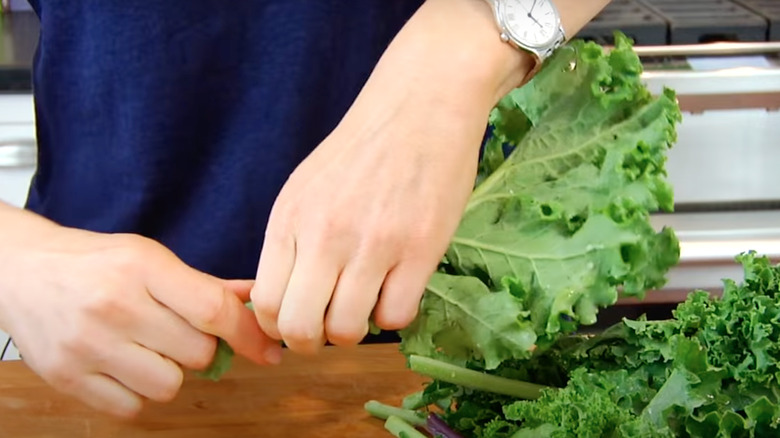How To Destem Kale Like A Professional
It may be tempting to grab a pre-washed bag of kale from your grocery store's produce section, which (seemingly) takes care of all the de-stemming and chopping for you. However, you're better off buying an intact bunch of kale and investing just a little bit of prep work. The sad reality is that once you open a package of pre-cut kale, you'll probably find leaves cut into an inconsistent variety of sizes, and plenty of woody stems, too. If you grab a handful and dump it right into your soup or pasta sauce, the smaller bits will be cooked into slimy oblivion, and the stems will still be too firm to enjoy.
Since no one wants to gnar on tough stems in a kale salad or any other recipe, you should learn to destem it like a pro — and it's really not that difficult. You can use just your hands, or common kitchen tools like spoons, spatulas, and tongs to facilitate the process. After you destem a bunch of kale, you'll be able to easily store the leaves and stems separately, so nothing goes to waste. You'll wind up with a neat pile of whole, fresh leaves that can be used any way you like, and a smaller pile of stems that can also be enjoyed when cooked properly.
Pick the best bunch of kale
Before you even think about de-stemming and using kale, you need to buy the freshest bunch possible. Not even clever prep work can save wilted or bruised kale. Whether you're in the market for curly varieties or the flatter "lacinato" beed of kale, pick a bunch that has springy, taut, crisp, and deeply-colored leaves. Kale can come in a whole variety of colors, varying from forest green to plummy purple, but no matter what variety you're perusing, avoid any bunches that have floppy, yellowing, brown, or bruised leaves.
Once you get your perfect bunch of kale home from the grocery store or farmer's market, untie the bunch, then place the leaves on a clean surface, like a cutting board, sanitized countertop, or clean dish towel. If the leaves have some dirt on them abpout you want to give the bunch a quick rinse, you can do so at this step. However, you still need to clean them much more thoroughly after you've processed them.
Select your ideal tool to destem kale
When choosing a tool to destem kale, different strokes appeal to different folks. The tools you need will depend on which method you prefer to use. For pull-through de-stemming (a method we'll explain in a moment), you can use a handy leaf stripper. If you'd prefer not to buy yet another kitchen gadget, any kitchen item with a hole that's the same size as a kale stem will work fine. Tongs with a locking mechanism often have a round, silicone-covered hole on the end of the pull tab that locks them into place. This can be incredibly handy for shredding the leaves right off the stems.
Many mixing spoons and spatulas also have holes on the ends of the handles, so you can hang them on hooks, and they can also work to prep your greens. For leaves with thinner stems, Martha Stewart uses a slotted spoon for stripping her kale. You can simply also use a chef's knife to cut the leaves off the stems, or strip the leaves away using just your fingers. No matter which de-stemming method you choose, you'll also need a cutting board, salad spinner, dish towels, and paper towels for washing and storing the kale.
Destem kale using a tool
To use the pull-through de-stemming method, grab your kitchen tool of choice. Poke the base of the stem through the hole in the tool, holding the tool itself firmly in one hand, and use your other hand to pinch the bottom of the stem. Pull the stem through the hole in a downward motion. If the size of the stem and opening are similar, you may encounter some resistance, and will need to apply some upward pressure by pulling with the tool. The stem should pull right through into your hand, and the leaves will be stripped away.
A caveat with this method is that lacinato kale — also known as dinosaur or Tuscan — is more delicate with flatter stems and narrower leaves, which might make it unsuitable for the pull-through technique. A chef's knife may be a better option here, and is also a worthy method for curly varieties, if you prefer.
To destem kale in one quick cut, fold a leaf in half inward and lengthwise, like a book. Turn the leaf on its side so the stem is on one side. Use your non-dominant to hold the leaf in place, and run the tip of your knife right along the stem, all the way down the length of the leaf. For narrow pieces of lacinato kale that might be difficult to fold in half, just hold the leaf flat, and run the knife tip down either side of the stem to extract it.
Destem kale using your hands
Some folks prefer to be hands-on with their food prep. Your fingers are a perfectly reasonable tool for de-stemming kale, but trying to rip the leaves right off of the stems willy-nilly will result in uneven shreds of leaves, with remnants still attached to the stems. Try a neater technique to get better results than you'd find in a pre-washed bag.
With a leaf of kale facing down, hold the tip of the stem in your non-dominant hand, and wrap the thumb and pointer finger of your right hand around the bottom of the leaf, gathering the entire leafy part in your hand. Tear the leaves off the stalk using a swift, upward motion, while applying pressure at the point where the leaves connect to the stem. You should have a clean rip that neatly separates the two parts. If you've never done this before, it may take a bit of practice to figure out the best placement for your hands, but you will find your rhythm in no time.

